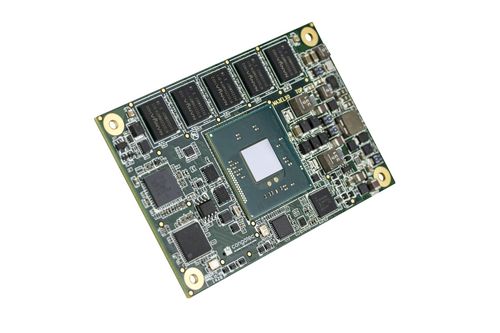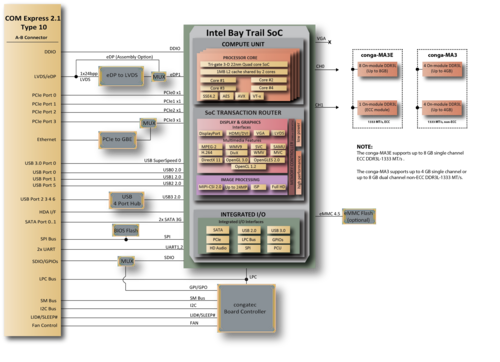COM Express Type 10
congatec enters COM Express Mini market with new Intel Atom and Celeron processors and ECC SupportType 10
German module expert congatec presents a small COM Express Computer-on-Module (COM) in the Mini form factor. Equipped with the new Intel Atom and Intel Celeron processors (codename Bay Trail) and thanks to their low power draw, the modules are ideal for x86-based mobile and semi-stationary applications in medical technology and industrial automation.The conga-MA3E now offers designers the safety and security of error correction code, often referred to as ECC memory, on a COM Express Mini Type 10 module.
Previous Atom processor generations are valued for their power efficiency, but scorned for their poor performance. This is little wonder; the microarchitecture has barely changed since the introduction of the Silverthorne architecture. Without a tick-tock model (alternating annual updates of microarchitecture and manufacturing technology) as adopted for the Core i series processors, updates have so far been limited to just a few extensions (Intel64, dual core, hyperthreading, HD-capable graphics) and adjustments to the manufacturing architecture. The poor performance of the previous graphics processor, missing features such as out-of-order execution and the absence of a turbo mode led to an ever greater distance to the more powerful models of the Core i series, and dwindling competitiveness in the face of the growing competition from ARM processors.
ECC (Error Correcting Code) Memory support
COM Express Type 10 continues to be a growing module segment and ECC memory support fits perfect in applications like telecommunications, financial and banking. Unlike standard RAM modules, ECC modules feature additional functions to check the data flow and adjust it as necessary in order to correct errors. The correction mode of this memory type can correct single bit errors and detect double bit errors. It therefore differs significantly from the so-called "parity bit", where errors can be detected but not corrected.
Successful revamp
The change to the new Silvermont microarchitecture with many useful and well-known extensions from the Core i series processors, the introduction of out-of-order execution to accelerate chain-of-command execution as well as more modern and competitive graphics with DX11 and OpenGL 3.2 support bring the new Atom and Celeron processors technologically back on trend. The new feature set and options put them significantly closer to the current Ivy Bridge generation. Because manufacturing is done using the latest 22 nm tri-gate transistor technology, production costs and power consumption are kept low while performance remains competitive. According to Intel, the same power consumption yields three times greater performance, while achieving the same performance requires only one-fifth of the power consumption of previous Atom processor generations. This means there is even more computing power available per watt than with the latest ARM processors. Another first is the fact that the Atom and Celeron processors are now also available as quad-core processors. These extend the range of the previous dual-core processors with hyperthreading, which is no longer available for the new processors. The updated turbo burst which, if necessary, allows individual cores and the graphics to be clocked much higher depending on the load within the thermal budget, ensures further performance gains.
The new features in detail
The graphics are based on Intel Gen7, just like the HD3000 of Ivy Bridge. However, the new Atom and Celeron processors only provide 4 instead of 16 execution units. The latest DirectX version 11 and OpenGL in version 3.2 are supported, as are hardware encoding/decoding of HD video, 3D stereoscopic output and two independent HD displays.
With the addition of AES-NI, the Atom and Celeron processors are for the first time providing hardware support for the widely used AES encryption algorithm. It is therefore now also possible to encrypt or decrypt data for transmission or storage with these processors in real time without burdening the CPU significantly. This is particularly important when using semiconductor mass storage devices (SSDs), since data can never be completely deleted. Intel® Virtualization VTx and thermal monitoring are also supported.
The new and improved power management supports power saving modes up to C6 and – like some previous models – Intel SpeedStep® technology. For added security, it is possible to designate a specific boot loader with the UEFI (Unified Extensible Firmware Interface) in the secure boot option to prevent the execution of malicious software and other unwanted or unauthorized programs.
With USB 3.0, DisplayPort, SATA Gen 2 and PCI Express Gen 2, the new Bay Trail processors are equipped with all the latest interfaces on-chip, thereby providing a true system-on-chip (SoC).
The below table gives an overview of the processor options and features for the congatec conga-MA3E module.
The benefits of the new COM Express Mini format
With the conga-MA3E COM Express Mini, customers receive not only a small, high-performance module measuring just 55x84mm², but also the related carrier boards and development systems, including software and support for the development of their own systems.
The conga-MA3E can be equipped with single-core to quad-core processors of the Atom E3xxx series or the appropriate embedded Celeron processors. Embedded Celeron refers to low-priced volume models of the Bay Trail family. A common feature of all processors is their single-chip design, with graphics and the appropriate chipset already integrated in the housing. A special bonus for embedded users is the long-term availability of processors and modules of at least seven years.
The modules are provided with up to 8 GB soldered DDR3L memory; standard 4GB eMMC Flash is available for mass storage which can be used as SSD or boot device.
The integrated graphics, which have been significantly improved since the previous model, support DirectX 11, OpenGL 3, OpenCL 1.2 and high-performance, flexible hardware decoding to decode multiple high-resolution full HD videos in parallel.
Up to 2,560 x 1,600 pixels with DisplayPort and 1,920 x 1,200 pixels with DDI are natively supported in the processor, and 1x 16 or 1x 24-bit LVDS is available.
Thanks to native USB 3.0 support, the modules achieve fast data transmission with low power consumption. A total of seven USB 2.0 ports and up to two USB 3.0 SuperSpeed ports are provided.
Four PCI Express 2.0 lanes and two SATA interfaces with up to 3 Gb/s enable fast and flexible system extension. The Intel® Gigabit Ethernet Controller I210 guarantees best software compatibility. ACPI 5.0, I2C bus, LPC bus for easy integration of legacy I/O interfaces and Intel® High Definition Audio complete the feature set.
Operating system support is available for Windows 8, Windows 7, and embedded Linux.
Possible areas of application

Due to their compact footprint, high performance and low power draw, the conga-MA3E is particularly well suited for compact and semi-stationary applications in the medical and industrial automation sector. Special benefits include long-term availability of at least 7 years for chip and board; integrated, touch-sensitive HD graphics with support of two independent, high-resolution screens; plus high operational reliability due to the exclusive use of ceramic capacitors. Unlike comparable ARM-based systems, full x86 code compatibility is provided with minimum power draw. Existing x86 applications can therefore continue to be used without porting them to a new platform.
Additional application areas include fanless, passively cooled digital signage and monitoring systems and display PCs as well as more standard industrial applications such as machine controllers. The performance is equal if not superior to recent Pentium and Celeron systems, which allows the use of compact, fully enclosed systems where complicated cooling solutions were previously required. The additional performance gain also allows the use of modern virtualization techniques, such as hypervisors.
A look into the future
Intel scored a major success with the new Atom and Celeron processor generation which finally closes the performance gap between previous Atom processors and the high-performance, but power-hungry processors of the Core i series — at a very attractive price. For the user, this opens up a world of performance levels that are superior to ARM without an increase in power consumption or the need to leave their tried and trusted x86 architecture.




